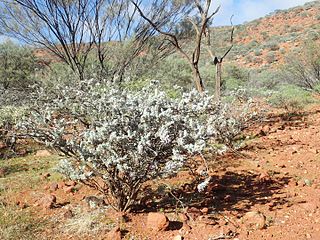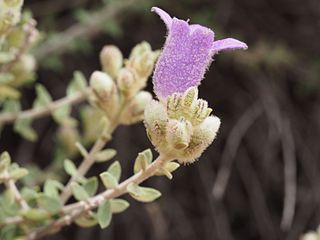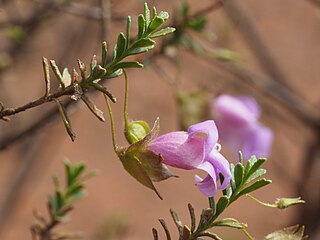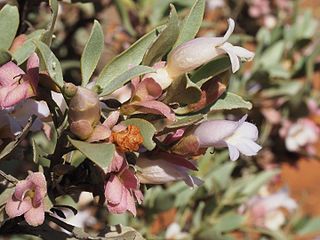
Eremophila caespitosa, commonly known as felty-leaved eremophila, is a flowering plant in the figwort family, Scrophulariaceae and is endemic to an area near the centre of Western Australia. It is a small shrub with a tuft-like habit, very hairy grey leaves and lilac to purple flowers.
Eremophila ciliata, commonly known as Archer's eremophila is a flowering plant in the figwort family, Scrophulariaceae and is endemic to a small area in the south of Western Australia. It is an erect, spreading shrub with short, thick leaves and small lilac to mauve flowers. It is only known from a population of about 100 plants.
Eremophila coacta is a flowering plant in the figwort family, Scrophulariaceae and is endemic to a small area in the north west of Western Australia. It is an erect shrub with narrow, sticky, pointed leaves and densely hairy light to dark lilac-coloured flowers.

Eremophila conferta is a flowering plant in the figwort family, Scrophulariaceae and is endemic to a small area in the central west of Western Australia. It is a shrub with many tangled branches with leaves crowded near their ends and with mauve or purple flowers.
Eremophila congesta is a flowering plant in the figwort family, Scrophulariaceae and is endemic to a small area in central areas of Western Australia. It is a grey-coloured shrub with crowded, hairy leaves and lilac-coloured flowers which are white inside.

Eremophila jucunda is a flowering plant in the figwort family, Scrophulariaceae and is endemic to Western Australia. It is a small to medium-sized shrub with hairy branches and leaves, lance-shaped to egg-shaped leaves and cream-coloured, lilac or purple flowers.

Eremophila lachnocalyx, commonly known as woolly-sepaled eremophila or woolly-calyxed eremophila, is a flowering plant in the figwort family, Scrophulariaceae and is endemic to Western Australia. It is an erect, spreading shrub with densely hairy, greyish leaves but its most distinctive feature is its densely woolly sepals.
Eremophila lanata is a flowering plant in the figwort family, Scrophulariaceae and is endemic to Western Australia. It is a small shrub with small, hairy leaves, densely hairy sepals and lilac to pinkish flowers.

Eremophila malacoides, commonly known as frontage poverty bush, is a flowering plant in the figwort family, Scrophulariaceae and is endemic to Western Australia. It is a shrub with grey-green foliage, densely hairy leaves, and usually lilac to purple flowers but a yellow flowered form also occurs.
Eremophila petrophila is a flowering plant in the figwort family, Scrophulariaceae and is endemic to Western Australia. It is a tall, erect, open shrub with rough branches, narrow, sticky leaves and pale lilac-coloured flowers.

Eremophila phyllopoda is a flowering plant in the figwort family, Scrophulariaceae and is endemic to Western Australia. It is an erect or spreading shrub, sometimes round or flat-topped with sticky, hairy leaves and flowers ranging in colour from pink or lilac to purple.

Eremophila punctata is a flowering plant in the figwort family, Scrophulariaceae and is endemic to Western Australia. It is an erect shrub with sticky young branches and leaves due to the presence of resin. Its small leaves usually have a few blunt teeth near their ends and flowers which are usually lilac-coloured. It is a distinctive and widespread species.

Eremophila reticulata is a flowering plant in the figwort family, Scrophulariaceae and is endemic to Western Australia. It is a dense shrub with egg-shaped leaves, colourful sepals and white or pink flowers.
Eremophila revoluta is a flowering plant in the figwort family, Scrophulariaceae and is endemic to Western Australia. It is a low, dense shrub with small, hairy leaves, very hairy sepals and mauve or purple petals.

Eremophila rhegos is a flowering plant in the figwort family, Scrophulariaceae and is endemic to Western Australia. It is an erect shrub with densely hairy leaves and branches and blue, mauve, purple or white flowers.

Eremophila rigens is a flowering plant in the figwort family, Scrophulariaceae and is endemic to Western Australia. It is an erect shrub with long, stiff, glabrous leaves and pale lilac-coloured to white flowers.

Eremophila spuria is a flowering plant in the figwort family, Scrophulariaceae and is endemic to Western Australia. It is an erect, open shrub with narrow leaves and blue, lilac, purple or white flowers and is a common and widespread species.

Eremophila ternifolia, commonly known as Wongan eremophila is a flowering plant in the figwort family, Scrophulariaceae and is endemic to Western Australia. It is a low, many-branched, shrub with short, pointed leaves and small lilac-coloured or mauve flowers.

Eremophila tietkensii is a flowering plant in the figwort family, Scrophulariaceae and is endemic to Australia. It is a rounded to flat-topped shrub with grey-green leaves, usually pinkish-purple sepals and mauve, pink or lilac-coloured petals. It is mostly found in Western Australia but also occurs in the far west of the Northern Territory.

Eremophila warnesii is a flowering plant in the figwort family, Scrophulariaceae and is endemic to Western Australia. It is an erect, compact shrub with furry leaves, hairy sepals and blue to mauve petals. It is a little-known species, named after the founder of the Eremophila Study Group.















